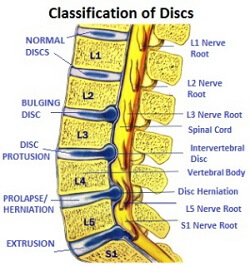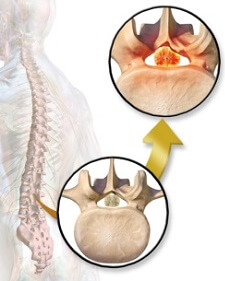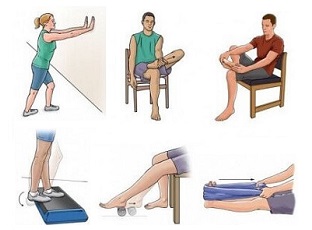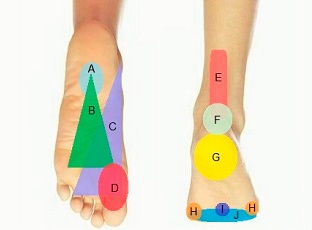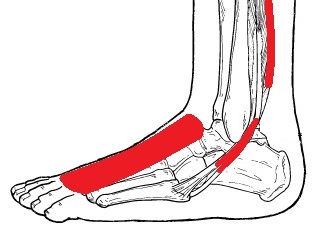- Home
- Diagnosis Guide
- Nerve Pain In Foot
Nerve Pain In Foot
Written By: Chloe Wilson BSc(Hons) Physiotherapy
Reviewed By: FPE Medical Review Board
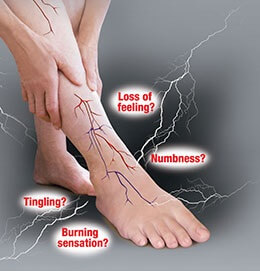
Nerve pain in the foot is a common problem. There may be burning foot pain, tinging, numbness or weakness. Symptoms may be confined to the foot however they often affect the leg too.
Nerve pain in the foot is typically caused by damage to the nerve somewhere along its path from the spine down to the foot.
This is usually either from an injury to the back, leg or foot, an underlying medical condition or a side effect of medication.
Nerves are responsible for carrying messages telling muscles how and when to work, providing information on different sensations such as hot and cold and controlling various bodily functions.
Damage anywhere along the course of a nerve affects its ability to carry these messages and can cause nerve pain in foot, also be known as a foot neuropathy or neuropathic pain.
What Causes Nerve Pain In Foot?
Nerve pain in foot can stem from two places:
- The Spine: Damage to the lower back is a common cause of nerve pain in the foot. This tends to cause back, buttock and leg nerve pain as well as foot pain and weakness.
- The Nerve: a peripheral foot neuropathy is caused by damage along the course of the nerve somewhere down the leg or in the foot itself. In this case symptoms tend to be localized to the foot and possibly lower leg.
Here, we will look at how nerves work, the most common causes of foot and leg nerve pain, how they present and how to know when nerve pain in foot is a medical emergency.
How Do Nerves Work?
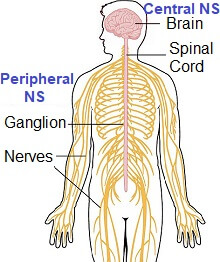
Our nervous system is made up of two systems, the central nervous system (brain and spinal cord) and the peripheral nervous system (nerves).
The peripheral nerves take messages to and from the brain and spinal cord which interpret the messages and send a responding signal back down to the starting point.
There are three types of nerves in our bodies:
- Sensory Nerves: receive information on different sensations such as hot/cold, sharp/dull, light/heavy pressure
- Motor Nerves: control how the muscles work telling them when, how long and how strongly they should contract and relax
- Autonomic Nerves: control things like bladder and bowel function, heart rate and digestion
Damage to the nerves causes them to behave abnormally. They may stop sending messages altogether e.g. causing numbness or weakness, or fire erratically, sending excessive or incorrect signals e.g. causing nerve pain in foot or tingling/pins and needles.
Neuropathic pain is often worse at night due to inflammation and often leads to foot pain in the morning.
Foot Neuropathy from Spinal Problems
Nerve pain in the foot often comes from a problem in the back, rather than in the foot itself. At the base of the spine, five nerves (L4, 5, S1, 2 &3) exit the spine and join together to form the sciatic nerve, the largest nerve in the body. The sciatic nerve travels down through the buttock and the back of the leg, branching out as it spreads further down through the leg and into the foot.
If the sciatic nerve is squashed anywhere along its path, it interrupts the signals travelling up and down the nerves to the spinal cord resulting in pain, weakness, tingling or numbness anywhere in the leg and down in to the foot.
The two most common problems in the lower back that can damage the sciatic nerve and thus cause nerve pain in foot are:
1. Herniated Disc aka Slipped Disc
Between most of the vertebrae in our back there are discs that provide cushioning and allow pain-free, flexible movement.
If discs get squashed too much, some of the material from the middle of the disc (the nucleus) gets pushed out of the back of the disc, irritating and/or squashing the nerve root.
Think of it like a jam donut, where the donut represents the disc, and the jam represents the nucleus. When you squeeze a donut, the jam leaks out the back, sticking to whatever it touches.
The most common symptoms of nerve pain in the foot from a herniated disc are:
- Pain: in the lower back which may spread down through the buttock, back of the leg and sometimes the foot. The pain tends to be sharp or burning rather than dull
- Altered Sensation: the pain may progress to pins and needles or numbness with or without associated weakness e.g. inability to lift the foot and toes up
- Unilateral Symptoms: Usually only affects one leg rather than both
In most cases, nerve pain in foot from spinal problems settles down within a few weeks with a combination of rest, exercises and medication. However, in a few cases, it can be a medical emergency – see below.
2. Spinal Stenosis
Spinal stenosis is another possible cause of nerve pain in foot. It develops due to narrowing of the gaps in the spine where the spinal cord and nerves run.
The most common symptoms of spinal stenosis in the lower back are burning foot pain and cramp, typically in both legs.
Spinal stenosis symptoms tend to ease when you sit down or bend forward, so people with stenosis often find it easier walking uphill than on the flat or downhill as you naturally bend forwards slightly.
Spinal stenosis can be caused by:
- Wear and Tear: As this can cause the production of bone spurs, small outgrowths of bone which stick out
- Tumours: Abnormal growths in the spinal cord
- Spinal Injuries: Injuries to the spine such as a fracture can cause inflammation or bone displacement
Nerve pain in the foot from spinal stenosis is usually linked with aging, most commonly affecting people over the age of 50. In severe cases, surgery may be indicated.
Nerve Pain From Peripheral Neuropathy
Peripheral neuropathy is a problem with the nerves that carry messages to and from the spinal cord and brain. It most commonly causes problems in the extremities i.e. hands and feet. Peripheral neuropathy can come on:
- Suddenly: usually due to a traumatic event (known as acute onset) or
- Gradually: tends to get progressively worse and is slow to improve (known as a chronic condition).
If one nerve is affected it is known as mononeuropathy, if more than one nerve is affected it is referred to as polyneuropathy. The damage from peripheral neuropathy can result in:
- Pain: Sharp, stabbing, electric shock or burning foot pain, often worse at night
- Weakness: difficulty moving the foot normally such as a foot drop (difficulty lifting the foot up)
- Altered Sensation: tingling, pins and needles and/or numbness, hypersensitivity. It can sometime feel like you are wearing a sock when you are actually barefoot.
- Altered Balance & Co-ordination: you may feel unsteady on your feet
Symptoms of peripheral neuropathy usually affect both feet, rather than just one and may come and go or gradually progress.
What Causes Peripheral Neuropathy?
There are a number of different causes of nerve pain in foot from peripheral neuropathy:
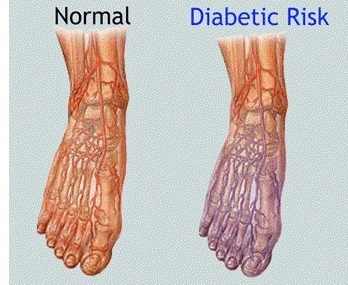
- Diabetes: is the most common cause of peripheral neuropathy. Diabetic nerve pain in foot results from changes in blood sugar levels which affects the metabolism of the nerves glucose levels. Anyone suffering from diabetes should take extra care of their feet and report any incidences of burning foot pain or foot neuropathy as they are at high risk of severe foot problems.
- Injuries: This may be from a one-off incident or from sustained or repetitive compression. A typical example of this is Tarsal Tunnel Syndrome which causes burning foot pain
- Infections: Such as Lyme Disease, shingles or leprosy
- Medications: Peripheral neuropathy can be a side effect of some medications e.g. chemotherapy drugs
- Alcoholism: Long term excessive alcohol intake can damage the peripheral nerves
- Charcot Marie Tooth Disease: can also cause peripheral neuropathy. Charcot Marie Tooth is a condition where damage to parts of the nerve fibre slows down transmission of signals, resulting in weakness and loss of sensation.
In approximately 30% of cases of peripheral neuropathy, the cause is idiopathic – of unknown origin.
When Is Nerve Pain in Foot Serious?
Any incidence of nerve pain in foot should be assessed by your doctor.
If you experience any of the following symptoms, you should see your
doctor immediately as these symptoms constitute a medical emergency:
- Bladder or Bowel Dysfunction: inability to control function
- Saddle Anaesthesia: numbness in your saddle region between your legs
- Weakness: e.g. foot drop where you are unable to pick up your foot properly causing you to stumble or trip frequently when walking
These are usually linked with a problem in the spine rather than a peripheral foot neuropathy.
If none of these causes of nerve pain in foot is sounding quite like your problem, visit the burning foot pain section for help working out what is causing your problem or the common foot conditions section.
Nerve Pain In Foot Summary
Nerve pain in the foot is a common problem often associated with tingling, numbness and weakness.
Foot nerve pain may stem from a problem in the spine, or damage anywhere along the course of the nerve from the back down to the foot.
Common spinal problems that cause nerve pain in the foot include a herniated disc are spinal stenosis.
Peripheral neuropathy can develop due to a number of factors including medical conditions e.g. diabetes, nerve compression e.g tarsal tunnel syndrome, infections e.g. lyme disease and some medications.
Symptoms to watch for with foot nerve pain that require immediate medical attention include lack of bladder/bowel control, severe weakness in the foot and saddle anaesthesia.
You may also be interested in the following articles:
- Pain On Top Of Foot
- Ball Of Foot Pain
- Foot Arch Pain
- Pain On Side Of Foot
- Foot Lumps & Bumps
- Heel Pain
- Morning Foot Pain
Related Articles
Page Last Updated: 05/12/23
Next Review Due: 05/12/25
References
